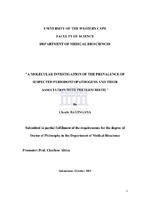| dc.contributor.advisor | Africa, Charlene | |
| dc.contributor.author | Claude, Bayingana | |
| dc.contributor.other | Dept. of Medical BioSciences | |
| dc.date.accessioned | 2014-03-13T10:19:37Z | |
| dc.date.available | 2013/07/08 | |
| dc.date.available | 2013/07/08 12:16 | |
| dc.date.available | 2014-03-13T10:19:37Z | |
| dc.date.issued | 2010 | |
| dc.identifier.uri | http://hdl.handle.net/11394/2980 | |
| dc.description | Philosophiae Doctor - PhD | en_US |
| dc.description.abstract | More than 20 million infants in the world (15.5 % of all births) are born with low birth weight. Ninety-five % of them are in developing countries. Oral colonization of Gramnegative anaerobes has been implicated as a risk factor for preterm delivery of low birth weight (PLBW) infants. The objective of this study was to investigate the association between periodontal pathogens and pre-term delivery of low birth weight (PLBW) infants. The study sample included 200 randomly selected women admitted to the department of obstetrics-gynecology of the teaching hospital of Butare in Rwanda. Mothers were asked to complete a questionnaire in order to identify factors which might pose a health risk to them and their infants. Gingival crevicular fluid (GCF) was collected from each quadrant of the mother’s month (using paper points) within 24 hours of delivery. Ten ml of foetal cord serum samples were collected at delivery and 10 ml of maternal serum samples were collected within 48 of delivery. GCF was examined by PCR for the presence of 5 periodontopathogens and ELISA was used for the evaluation of cytokines (IL-6 and IL-10) and immunoglobulins (IgM, IgG) in foetal cord and maternal blood against the periodontopathogens. P. intermedia showed significant associations either on its own or in combinations with most indicators of periodontal disease used in this study, while Aa and members of the red complex were significantly associated with gum bleeding and reduced frequency of tooth brushing. A strong association between PLBW and maternal and foetal cord serum sample levels of IL-10 was observed. Also, a good association was observed between PLBW and FCB sample levels of IL-6. Significant associations were observed between PLBW and maternal IgG against the different peridontopathogens. The findings of this study may suggest that the levels of maternal IgG and foetal IgM against the different periodontopathogens are associated with dissemination of maternal periodontopathogens to the foetus thereby illiciting an inflammatory response which contributes to PLBW. | en_US |
| dc.language.iso | en | en_US |
| dc.publisher | University of the Western Cape | en_US |
| dc.subject | Preterm birth | en_US |
| dc.subject | Periodontal disease | en_US |
| dc.subject | Cytokines | en_US |
| dc.subject | Pregnancy | en_US |
| dc.subject | Anaerobes | en_US |
| dc.subject | Immunoglobulins | en_US |
| dc.subject | Molecular | en_US |
| dc.subject | Periodontal pathogens | en_US |
| dc.subject | Polymerase Chain Reaction (PCR) | en_US |
| dc.subject | Enzyme Linked Immunosorbent Assay (ELISA) | en_US |
| dc.title | A molecular investigation of the prevalence of suspected periodontopathogens and their association with preterm birth | en_US |
| dc.rights.holder | Copyright: University of the Western Cape | en_US |
| dc.description.country | South Africa | |

